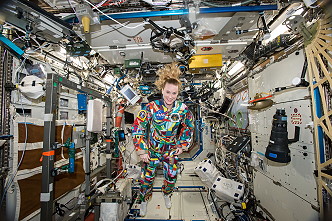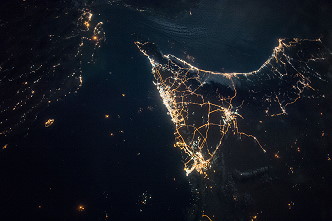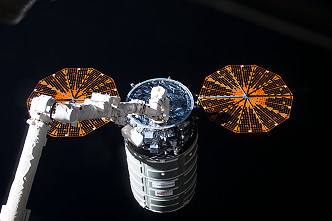Resident Crews of the International Space Station (ISS)
![]()
ISS: Expedition 49 |
 |
 |
 |
alternative crew photo |
|
alternative crew photo |
|
alternative crew photo |
|
 |
 |
![]()
Crew, launch- and landing data
| No. | Nation | Surname | Given names | Position | Spacecraft (launch) |
Launch date |
Launch time |
Spacecraft (landing) |
Landing date |
Landing time |
Mission duration |
Orbits |
| 1 | Ivanishin | Anatoli Alekseyevich | ISS-CDR | Soyuz MS | 07.07.2016 | 01:36:40.208 UTC | Soyuz MS | 30.10.2016 | 03:58:23.3 UTC | 115d 02h 21m 43s | 1792 | |
| 2 | Ryzhikov | Sergei Nikolaevich | Flight Engineer-1 | Soyuz MS-02 | 19.10.2016 | 08:05:14.378 UTC | Soyuz MS-02 | 10.04.2017 | 11:20:21.6 UTC | * 173d 03h 15m 08s | 2694 | |
| 3 | Borisenko | Andrei Ivanovich | Flight Engineer-2 | Soyuz MS-02 | 19.10.2016 | 08:05:14.378 UTC | Soyuz MS-02 | 10.04.2017 | 11:20:21.6 UTC | * 173d 03h 15m 08s | 2694 | |
| 4 | Kimbrough | Robert Shane | Flight Engineer-3 | Soyuz MS-02 | 19.10.2016 | 08:05:14.378 UTC | Soyuz MS-02 | 10.04.2017 | 11:20:21.6 UTC | * 173d 03h 15m 08s | 2694 | |
| 5 | Onishi | Takuya | Flight Engineer-5 | Soyuz MS | 07.07.2016 | 01:36:40.208 UTC | Soyuz MS | 30.10.2016 | 03:58:23.3 UTC | 115d 02h 21m 43s | 1792 | |
| 6 | Rubins | Kathleen Hallisey "Kate" | Flight Engineer-6 | Soyuz MS | 07.07.2016 | 01:36:40.208 UTC | Soyuz MS | 30.10.2016 | 03:58:23.3 UTC | 115d 02h 21m 43s | 1792 |
* including a leap second on December 31, 2016 at 23:59:60 UTC
unofficial Backup Crew
| No. | Nation | Surname | Given names | Position |
| 1 | Novitsky | Oleg Viktorovich | ISS-CDR | |
| 2 | Misurkin | Aleksandr Aleksandrovich | Flight Engineer | |
| 3 | Tikhonov | Nikolai Vladimirovich | Flight Engineer | |
| 4 | Vande Hei | Mark Thomas | Flight Engineer | |
| 5 | Pesquet | Thomas Gautier | Flight Engineer | |
| 6 | Whitson | Peggy Annette | Flight Engineer |
 |
 |
|
credit: European Space Agency / Roscosmos |
 |
Expedition Report
|
ISS Expedition 49 began with the undocking of
spacecraft Soyuz TMA-20M on September 06, 2016 at 21:51:31
UTC. The former Expedition 48 (Jeffrey
Williams, Aleksei
Ovchinin and Oleg
Skripochka) returned safely to Earth. On September 10, 2016, an ISS reboost was performed using Progress MS-02 R&D thrusters. This reboost was to set up for Soyuz MS-02 launch on September 23, 2016. The engines started at 00:45 UTC and fired 610.3 seconds. The ISS got 1.22 m/sec more speed. The orbit was 2.2 kilometers raised. The unmanned Progress MS-02 cargo ship undocked from the International Space Station on October 14, 2016 at 09:38:30 UTC. The freighter was filled with trash and later deorbited into the Earth's atmosphere during which it will burn up over the Pacific Ocean. The launch of the next Orbital ATK Commercial Resupply Services Cygnus OA-5 ("SS Alan Poindexter") mission to the International Space Station on an Antares rocket from the Mid-Atlantic Regional Spaceport's Pad-0A at Wallops occurred on October 17, 2016 at 23:45 UTC. The spacecraft carried crew supplies and vehicle hardware to the orbiting laboratory to support the Expedition 49 and 50 crews. This was the sixth cargo resupply mission by Orbital ATK under NASA's Commercial Resupply Services contract. Cargo resupply by U.S. companies ensures a national capability to deliver critical science research to the space station, significantly increasing NASA's ability to conduct new science investigations using the only microgravity laboratory. This was the first resupply mission to launch on the upgraded Antares 230 vehicle, and the first launch from Wallops since an Antares rocket and its Cygnus resupply vehicle were lost seconds after liftoff in October 2014. Since the accident, two Cygnus resupply missions launched on United Launch Alliance Atlas 5 rockets to the station from the Cape Canaveral Air Force Station in Florida. Cygnus carried to the space station more than 5,100 pounds (2,300 kg) of science and research in support of dozens of research investigations, as well as crew supplies and hardware. The new experiments included an investigation that looks at fuels that burn very hot at first, and then appear to go out, but actually continue to burn at a much lower temperature with no visible flames. A second planned large-scale fire inside Cygnus was ignited after it left the space station to help researchers understand how fire grows in microgravity and design safeguards for future space missions. Cygnus also carried a new station research facility that will enable a new class of research experiments by allowing precise control of motion in the microgravity environment aboard the station. Following a two days solo flight Soyuz MS-02 docked to ISS on October 21, 2016. Sergei Ryzhikov, Andrei Borisenko and Shane Kimbrough became the ISS Expedition 49 (together with ISS Expedition 48 crew members Anatoli Ivanishin, Takuya Onishi and Kathleen Rubins). With the arrival Expedition 49 became a six-person-crew. During their two-day transit from the launch pad at the Baikonur Cosmodrome in Kazakhstan to the station, the crew tested a variety of upgraded systems on their Soyuz MS-02 spacecraft. The modified Soyuz is equipped with upgraded thrusters that are fully redundant, additional micrometeoroid debris shielding, redundant electrical motors for the Soyuz' docking probe and increased power with more photovoltaic cells on the spacecraft's solar arrays. The Cygnus spacecraft arrived at the station on October 23, 2016. Expedition 49 astronauts Kathleen Rubins and Takuya Onishi used the space station's robotic arm to grapple Cygnus about 11:28 UTC. After Canadarm2 captured Cygnus, ground commands were sent to guide the station's robotic arm as it rotates and attaches the spacecraft to the bottom of the station's Unity module. Cygnus remained at the space station until November 21, 2016, when the spacecraft was used to dispose of several tons of trash during its fiery reentry into Earth's atmosphere, and conducted the spacecraft fire experiment. Finally, the station command changed from Russian cosmonaut Anatoli Ivanishin to US astronaut Shane Kimbrough. With undocking of Soyuz MS, carrying Anatoli Ivanishin, Takuya Onishi and Kathleen Rubins, on October 30, 2016 at 00:35 UTC the Expedition 49 concluded and the new ISS Expedition 50 began. During the stay on board of the ISS the crews of Expeditions 49 / 50 carried out the following scientific experiments (without Russian experiments): ACE-T-1 (Advanced Colloids Experiment-Temperature control-1) ACME (Advanced Combustion Microgravity Experiment) AMO-EXPRESS 2.0 (Autonomous Mission Operations EXPRESS 2.0 Project) AMS-02 (Alpha Magnetic Spectrometer - 02) APEX-02-2 (Advanced Plant EXperiments-02-2) APEX-04 (Epigenetic change in Arabidopsis thaliana in response to spaceflight - differential cytosine DNA methylation of plants on the ISS) ATOMIZATION (Detailed validation of the new atomization concept derived from drop tower experiments - Aimed at developing a turbulent atomization simulator) Aerosol Samplers (Aerosol Sampling Experiment) Area PADLES (Area Passive Dosimeter for Life-Science Experiments in Space) At Home in Space (Culture, Values, and Environmental Adaptation in Space) Auxin Transport (Studies on gravity-controlled growth and development in plants using true microgravity conditions) BASS-II (Burning and Suppression of Solids - II) BEAM (Bigelow Expandable Activity Module) Biochem Profile (Biochemical Profile) Biological Rhythms 48hrs (The effect of long-term microgravity exposure on cardiac autonomic function by analyzing 48-hours electrocardiogram) Bisphosphonates (Bisphosphonates as a Countermeasure to Space Flight Induced Bone Loss) Body Measures (Quantification of In-Flight Physical Changes - Anthropometry and Neutral Body Posture) Brain-DTI (Brain-DTI) CALET (CALorimetric Electron Telescope) CARTILAGE (CARTILAGE) CASIS PCG 5 (Microgravity Growth of Crystalline Monoclonal Antibodies for Pharmaceutical Applications) CATS (Cloud-Aerosol Transport System) CEO (Crew Earth Observations) CFE-2 (Capillary Flow Experiment - 2) CLYC-Crystal Growth (Crystal Growth of Cs2LiYCl6:Ce Scintillators in Microgravity) Cardio Ox (Defining the Relationship Between Biomarkers of Oxidative and Inflammatory Stress and the Risk for Atherosclerosis in Astronauts During and After Long-duration Spaceflight) Circadian Rhythms (Circadian Rhythms) Cool Flames Investigation (Cool Flames Investigation) DECLIC HTI-R (DEvice for the study of Critical LIquids and Crystallization - High Temperature Insert-Reflight) DOSIS-3D (Dose Distribution Inside the International Space Station - 3D) Dose Tracker (Dose Tracker Application for Monitoring Medication Usage, Symptoms, and Adverse Effects During Missions) EDOS (Early Detection of Osteoporosis in Space) ESA-Active-Dosimeters (European Crew Personal Active Dosimeter) ESA-Haptics-1 (ESA-Haptics-1) Energy (Astronaut's Energy Requirements for Long-Term Space Flight) FLEX-2 (Flame Extinguishment Experiment - 2) Field Test (Recovery of Functional Sensorimotor Performance Following Long Duration Space Flight) Fine Motor Skills (Effects of Long-Duration Microgravity on Fine Motor Skills: 1 year ISS Investigation) Fluid Shifts (Fluid Shifts Before, During and After Prolonged Space Flight and Their Association with Intracranial Pressure and Visual Impairment) Fruit Fly Lab -02 (FFL-02) (The effects of microgravity on cardiac function, structure and gene expression using the Drosophila model) Functional Immune (Functional Immune Alterations, Latent Herpesvirus Reactivation, Physiological Stress and Clinical Incidence Onboard the International Space Station) Gecko Gripper (Gecko Gripper) Group Combustion (Elucidation of Flame Spread and Group Combustion Excitation Mechanism of Randomly-distributed Droplet Clouds) HDEV (High Definition Earth Viewing) Habitability (Habitability Assessment of International Space Station) IPVI (Non-invasive assessment of intracranial pressure for space flight and related visual impairment) ISS Ham Radio (ARISS) (International Space Station Ham Radio (also known as Amateur Radio on the International Space Station (ARISS))) ISS RapidScat (ISS-RapidScat) Immuno-2 (Immuno-2) Interfacial Energy 1 (Interfacial phenomena and thermophysical properties of high-temperature liquids-Fundamental research of steel processing using electrostatic levitation) Intervertebral Disc Damage (Risk of Intervertebral Disc Damage after Prolonged Space Flight) JAXA ELF (Electrostatic Levitation Furnace (ELF)) JAXA Low Temp PCG (JAXA Low Temperature Protein Crystal Growth) JAXA PCG (Japan Aerospace Exploration Agency Protein Crystallization Growth) LDST (Long Duration Sorbent Testbed) LMM Biophysics 3 (Growth Rate Dispersion as a Predictive Indicator for Biological Crystal Samples Where Quality Can be Improved with Microgravity Growth) Lighting Effects (Testing Solid State Lighting Countermeasures to Improve Circadian Adaptation, Sleep, and Performance During High Fidelity Analog and Flight Studies for the International Space Station) MAGVECTOR (MagVector) MAXI (Monitor of All-sky X-ray Image) MED-2 (Miniature Exercise Device) MISSE-8 FSE (MISSE-8 FSE) MSL SCA-Batch 2b-ESA (Material Science Lab Batch 2b) MSL SCA-GEDS-German (NASA Sample Cartridge Assembly) MUSCLE BIOPSY (Muscle Biopsy) MVIS Controller-1 (MVIS Controller-1) Marangoni-UVP (Spatio-temporal Flow Structure in Marangoni Convection) Maritime Awareness (Global AIS on Space Station (GLASS)) Marrow (The MARROW study (Bone Marrow Adipose Reaction: Red Or White?)) Medical Consumables Tracking (Medical Consumables Tracking) Meteor (Meteor Composition Determination) Microbe-IV (Microbiological monitoring in the International Space Station-KIBO) Multi-Omics (Multi-omics analysis of human microbial-metabolic cross-talk in the space ecosystem) NICER (Neutron Star Interior Composition Explorer) NanoRacks-ALTAIR™ Pathfinder (NanoRacks-ALTAIR™ Pathfinder) NanoRacks-CID (NanoRacks-CID) NanoRacks-DM (NanoRacks-DM) NanoRacks-JAMSS-2, Lagrange-1 (NanoRacks-JAMSS-2, Lagrange-1) NanoRacks-Planet Labs-Dove (NanoRacks-Planet Labs-Dove) NeuroMapping (Spaceflight Effects on Neurocognitive Performance: Extent, Longevity, and Neural Bases) OPALS (Optical PAyload for Lasercomm Science) PBRE (Packed Bed Reactor Experiment) PK-4 (Plasma Kristall-4) PS-TEPC (Establishment of dosimetric technique in the International Space Station (ISS) with Position Sensitive Tissue Equivalent Proportional Chamber) Personal CO2 Monitor (Personal CO2 Monitor) Phase Change HX (Phase Change Heat Exchanger Project) Probiotics (Study for evaluating the impact of continuous consumption of probiotics on immune function and intestinal microbiota in astronauts under closed microgravity environment) RED-Data2 (Thermal Protection Material Flight Test and Reentry Data Collection) RFID Logistics Awareness (RFID-Enabled Autonomous Logistics Management (REALM)) ROSA (Roll-Out Solar Array) RTcMISS (Radiation Tolerant Computer Mission on the ISS) Radi-N2 (Radi-N2 Neutron Field Study) Radiation Environment Monitor (Radiation Environment Monitor) Repository (National Aeronautics and Space Administration Biological Specimen Repository) Robonaut (Robonaut) Rodent Research-4 (CASIS) (Tissue Regeneration-Bone Defect) SAGE III-ISS (Stratospheric Aerosol and Gas Experiment III-ISS) SCAN Testbed (Space Communications and Navigation Testbed) SEDA-AP (Space Environment Data Acquisition Equipment - Attached Payload) SGSat (Validation of a CubeSat Stellar Gyroscope System) SODI-DCMIX (SODI-DCMIX) SPHERES-Zero-Robotics (Synchronized Position Hold, Engage, Reorient, Experimental Satellites-Zero-Robotics) STP-H5 CSP (STP-H5-Center for High-performance REconfigurable Computing (CHREC) Space Processor) STP-H5 EHD (STP-H5-Electro-Hydro Dynamics) STP-H5 FPS (STP-H5-Fabry Perot Spectrometer for Methane) STP-H5 ICE (STP-H5-Innovative Coatings Experiment) STP-H5 LIS (STP-H5-Lightning Imaging Sensor) STP-H5 LITES (STP-H5-Limb-Imaging Ionospheric and Thermospheric Extreme-Ultraviolet Spectrographs) STP-H5 RHEME (STP-H5-Radiation Hardened Electronic Memory Experiment) STP-H5 Raven (Raven) STP-H5 SHM (STP-H5-Structural Health Monitoring) STP-H5 Space Cube - Mini (STP-H5-SpaceCube - Mini) Saffire-III (Spacecraft Fire Experiment-III) Sally Ride EarthKAM (Sally Ride Earth Knowledge Acquired by Middle School Students) Sarcolab (Myotendinous and Neuromuscular Adaptation to Long-term Spaceflight) Seedling Growth-3 (Seedling Growth-3) Skin-B (Skin-B) Skinsuit (Operational Evaluation of the Gravity Loading Countermeasure SkinSuit) Slosh Coating (Slosh Coating Experiment) Solar-SOLACES (Sun Monitoring on the External Payload Facility of Columbus - SOLar Auto-Calibrating EUV/UV Spectrophotometers) Solar-SOLSPEC (Sun Monitoring on the External Payload Facility of Columbus -Sun Monitoring on the External Payload Facility of Columbus -SOLar SPECtral Irradiance Measurements) Space Headaches (Space Headaches) Space Pup (Effect of space environment on mammalian reproduction) Stem Cells (Study on the Effect of Space Environment to Embryonic Stem Cells to Their Development) Straight Ahead in Microgravity (Straight Ahead in Microgravity) Strata-1 (Strata-1) Synergy (The elucidation of the re-adaptation on the attitude control after return from long term space flight) TBone (Assessment of the effect of space flight on bone quality using three-dimensional high resolution peripheral quantitative computed tomography (HR-pQCT)) TROPICAL CYCLONE (The Cyclone Intensity Measurements from the ISS (CyMISS)) TechEdSat-5 (Development of On-Demand Sample Return Capability - Small Payload Quick Return) Telescience Resource Kit (Flight Demonstration of Telescience Resource Kit) Telomeres (Assessing Telomere Lengths and Telomerase Activity in Astronauts) Tomatosphere 5 (Tomatosphere 5) Try Zero-G for Asia (Try Zero-G for Asia) UBNT (Ultrasonic Background Noise Test) Vascular Echo (Cardiac and Vessel Structure and Function with Long-Duration Space Flight and Recovery) Veg-03 (Veg-03) Vessel ID System (Vessel ID System) Water Monitoring Suite (Water Monitoring Suite) Windows on Earth (Windows on Earth) ZBOT (Zero Boil-Off Tank) |
Photos
 |
 |
 |
 |
 |
 |
 |
 |
 |
 |
 |
 |
 |
 |
 |
|
more Earth observation photos |
|
more onboard photos |
|
| © |  |
Last update on December 15, 2020.  |
 |